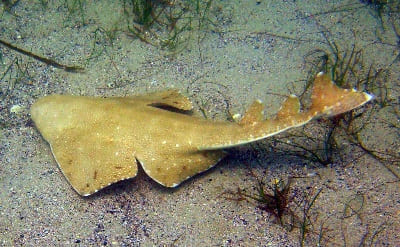Home › Sea Life Facts › Marine › Vertebrates › Sharks › Angel Shark
Interesting Facts about Angel Sharks
[Phylum: Chordata] [Class: Chondrichthyes] [Order: Squatiniformes] [Family: Squatinidae]
Several biological differences and unique predatory habits distinguish the common angel shark (Squatina squatina) from most other sharks.
This guide contains fun facts and information about angelsharks, including where they live, what they eat, and why some species are critically endangered.
Angel Shark Facts: Habitat and Distribution
This is a typical bottom feeder that spends more time buried in sand or mud than it does free swimming.
So, they conceal themselves around sediment deposits of most coastal and outer-continental shelf regions.
The optimum conditions needed for the angel shark habitat are found in the Eastern Atlantic, the Black Sea, Norway, and the Mediterranean basin.
In these zones, they tend to occupy areas near river mouths and other marine biomes with brackish water.
Angel shark populations have fallen dramatically in recent years. Nonetheless, divers can catch sightings of these batoid sharks most often around the coastline of Great Britain and in the Canary Islands.
Pro Tip: The destinations help guide contains information about the best scuba diving in Europe for beginners with extra details about where to find pelagic sharks.
Angel Shark Behaviour and Characteristics
In fact, there are more than twenty different species of angel sharks worldwide. But, Squatina squatina is the easy one to recognise (also called monkfish).
It has the trademark flattened head and body, with large 'wing-like' pectoral and pelvic fins. However, the common angel shark has five (5) gill slits at the side of the head (not underneath like rays) and it doesn't have any anal fin that most shark species have.
Nonetheless, when these elusive creatures bury themselves in the sand near reefs and canyons, some divers often mistake them for skate fish or stingrays.
They are somewhat migratory. So, the majority of angel shark species will move closer to the poles as the season changes.
Here's the thing:
Most angelsharks will be less than two metres long (5 feet) and weigh around 35 kg when they fully mature. But, the Japanese angel shark is one of the biggest, measuring well over six (6) feet.
 In the wild, the angel shark lifespan is notably long with some specimens living for around 35 years.
In the wild, the angel shark lifespan is notably long with some specimens living for around 35 years.
Most of the genus prefers shallow temperate waters. Even so, there have been sightings at depths around 150 metres (500 feet).
The mottled skin colour of the common angel shark creates a 'muddy' camouflage to help them capture prey.
Thus, they tend to display mixes of brown, gray, green, black, and red dots with a smooth white underbelly.
What Do Angel Sharks Eat?
Having eyes on the top of the head means they can lay in wait and look out for prey. The angel shark mouth is huge, and their razor sharp teeth combine well with a blunted snout.
There are two barbels at the tip of the snout. Like whiskers, these act as sensory organs for detecting their favourite diet, such as:
- Bony fishes (e.g. flatfishes)
- Crustaceans
- Marine mollusks
- Sea birds
- Sea skates
- Squid
Angel sharks are carnivorous and most active in darkness. So, they use the bioluminescent plankton to help them identify their prey.
Fun Fact: The angel shark is a master of disguise while it waits hidden in the sand. Despite being rarely seen by scuba divers, it is a stealthy predator and a vital species for a healthy ocean.
Angel Shark Reproduction
In fact, the young get nourishment from a yolk sac inside the uterus of the mother (known as placental viviparity). Thus, baby angel sharks are born alive.
During a three year reproductive cycle, a female angel shark will gestate for eight to twelve months and birth up to 25 live pups.
Interesting fact:
Newborn angel sharks are quite small, measuring about thirty (30) centimetres long (12 inches). But, the juveniles use fake eye markings (ocellus) as a defencive mechanism against their predators.
After reaching adulthood, the ocellus disappear and the sharks start to become sexually mature after reaching the age of eight (8) years.
Angel Shark Predators and Threats
Despite having few 'natural' predators, reports from the IUCN state that populations of angelsharks are decreasing at a rapid rate. Ongoing threats to this critically endangered species include:
- A slow rate of reproduction
- Broadnose sevengill shark
- Commercial and artisanal fishing
- Great white sharks
- Humans behaviour
- Northern elephant seals
Pro Tip: Another section explains why humans are the deadliest animal and why sharks do not kill most humans - nowhere near!
Related Information and Help Guides
- Blue Shark Interesting Facts and Information with Pictures
- Bull Shark Reproduction and Life Cycle
- Fun and Interesting Facts about Hammerheads (Sphyrnidae)
- Horn Shark Fun Facts and Information (Heterodontus Francisci)
- Leopard Shark Behaviour and Characteristics
- List of Animals that have Killed the Most Humans
- Nurse Shark Interesting Facts and Information with Pictures
Note: The short video [2:35 minutes] presented by "Deep Marine Scenes" contains even more angel shark facts with footage of Squatinidae squatina swimming and feeding in its natural habitat.